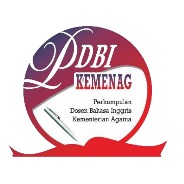The Effectiveness of Computer-Assisted Language Learning (CALL) by Smartphones to Increase English Proficiency of Papuan EFL Students
Abstract
This study aims to find out the effectiveness of Computer-Assisted Language Learning (CALL) by smartphones to increase English proficiency of Papuan EFL students. The mixed method was implemented specifically related to the explanatory sequential design (Quantitative-Qualitative) where the research design comprised two interactive sequential stages. The first stage was carried out by collecting and analyzing quantitative data using the pre-experimental method to find out the difference before and after being given treatment. The samples were determined using purposive sampling where 30 Papuan EFL students were selected, and data were analyzed by using SPSS. The second stage was carried out by collecting and analyzing qualitative data using structured interviews. The samples were determined using purposive sampling also, and 7 Papuan EFL students were considered representative to obtain data. The results show that Computer-Assisted Language Learning (CALL) by smartphones is effective to increase English proficiency of Papuan EFL students by a significant increase of 38.70%. The effectiveness of this learning cannot be separated from the aspects of efficiency, flexibility, and accessibility supported by excellence in terms of visualization and auditory systems. Moreover, some factors that certainly become constraints of Computer-Assisted Language Learning (CALL) including internet networks, small screens, notifications and advertisements, lack of proficiency towards applications, unsupported smartphones, and battery power. By solving all these constraints, CALL can be more effective to be applied in teaching and learning. The significant implication provides better change in the world of education through learning strategies in utilizing technology especially certain context and conditions in Papua.
Keywords
Full Text:
PDFReferences
Al Seghayer, K. (2013). The impact of four reading motivational constructs on motivating EFL learners to read online texts in English. International Journal of Computer-Assisted Language Learning and Teaching (IJCALLT), 3(2), 56–81.
Annisa, R., Nadila, S. M., Salsabila, S. A., Putri, S. A. E., & Nurmajesti, H. (2020). E-learning as an adaptation strategy in facing Covid-19 pandemic: A case study on the 2018 and 2019-generation students of post graduate Sociology Department, University of Indonesia. 6th International Conference on Social and Political Sciences (ICOSAPS 2020), 40–44.
Beatty, K. (2013). Teaching & researching: Computer-assisted language learning. Routledge.
Creswell, J. W., & Clark, V. L. P. (2017). Designing and conducting mixed methods research. Sage publications.
Dalton, D. W., & Hannafin, M. J. (1987). The effects of word processing on written composition. The Journal of Educational Research, 80(6), 338–342.
Dizon, G. (2021). Affordances and constraints of intelligent personal assistants for second-language learning. RELC Journal, 00336882211020548.
Fuady, R., & Mutalib, A. A. (2018). Audio-visual media in learning. Journal of K6 Education and Management, 1(2), 1–6.
Gheytasi, M., Azizifar, A., & Gowhary, H. (2020). The effect of smartphones on the reading comprehension proficiency of Iranian EFL learners. Procedia-Social and Behavioral Sciences, 199, 225–230.
Glackin, B. C., Rodenhiser, R. W., & Herzog, B. (2014). A library and the disciplines: A collaborative project assessing the impact of eBooks and mobile devices on student learning. The Journal of Academic Librarianship, 40(3–4), 299–306.
Han, Y. (2020). Connecting the past to the future of computer-assisted language learning: theory, practice, and research. Issues and Trends in Learning Technologies, 8(1), 1–13.
Huang, L.-S. (2011). Corpus-aided language learning. ELT Journal, 65(4), 481–484.
Hwang, W.-Y., Shadiev, R., Hsu, J.-L., Huang, Y.-M., Hsu, G.-L., & Lin, Y.-C. (2016). Effects of storytelling to facilitate EFL speaking using Web-based multimedia system. Computer Assisted Language Learning, 29(2), 215–241.
Keengwe, J., & Georgina, D. (2018). The digital course training workshop for online learning and teaching. Education and Information Technologies, 17, 365–379.
Kim, H., & Kwon, Y. (2012). Exploring smartphone applications for effective mobile-assisted language learning. Multimedia-Assisted Language Learning, 15(1), 31–57.
Kılıçkaya, F. (2015). Computer-based grammar instruction in an EFL context: Improving the effectiveness of teaching adverbial clauses. Computer Assisted Language Learning, 28(4), 325–340.
Klimova, B., & Kacet, J. (2017). Efficacy of computer games on language learning. Turkish Online Journal of Educational Technology-TOJET, 16(4), 19–26.
Ko, M.-H. (2019). Students’ reactions to using smartphones and social media for vocabulary feedback. Computer Assisted Language Learning, 32(8), 920–944.
Lee, L. (2017). Learners’ perceptions of the effectiveness of blogging for L2 writing in fully online language courses. International Journal of Computer-Assisted Language Learning and Teaching (IJCALLT), 7(1), 19–33.
Levy, M., Blin, F., Siskin, C. B., & Takeuchi, O. (2011). WorldCALL: International perspectives on computer-assisted language learning (Vol. 5). Routledge.
Li, Z., & Hegelheimer, V. (2013). Mobile-assisted grammar exercises: Effects on self-editing in L2 writing.
Luo, B. (2016). Evaluating a computer-assisted pronunciation training (CAPT) technique for efficient classroom instruction. Computer Assisted Language Learning, 29(3), 451–476.
Luppicini, R. (2007). Review of computer mediated communication research for education. Instructional Science, 35, 141–185.
Mahsud, M., Khalaf, A. J. M., Mahsud, Z., Afzal, A., & Afzal, F. (2021). Addiction to smartphones leading to distraction in the classrooms: Effect of different cultures. Journal of Statistics and Management Systems, 24(4), 741–754.
Martin, I. A. (2020). Pronunciation development and instruction in distance language learning.
Myrberg, C., & Wiberg, N. (2015). Screen vs. paper: what is the difference for reading and learning?
Nunan, D. (2015). Teaching English to speakers of other languages: An introduction. Routledge.
Nuraeni, C., Carolina, I., Supriyatna, A., Widiati, W., & Bahri, S. (2020). Mobile-Assisted Language Learning (MALL): Students’ perception and problems towards mobile learning in English language. Journal of Physics: Conference Series, 1641(1), 12027.
Pengnate, W. (2018). Students’ attitudes and problems towards the use of mobile-assisted language learning (MALL). 2018 5th International Conference on Business and Industrial Research (ICBIR), 590–593.
Sormunen, K., Lavonen, J., & Juuti, K. (2019). Overcoming Learning Difficulties with Smartphones in an Inclusive Primary Science Class. Journal of Education and Learning, 8(3), 21–34.
Ta’amneh, M. A. A. A. (2021). The Use of Smartphones in Learning English Language Skills: A Study of University Students’ Perspectives. International Journal of Applied Linguistics and English Literature, 10(1), 1–8.
Thomas, M., Reinders, H., & Warschauer, M. (2012). Contemporary computer-assisted language learning. A&C Black.
Torres, M. C. C., Salamanca, Y. N. S., Cely, J. P. C., & Aguilar, J. L. B. (2020). All we need is a boost! Using multimodal tools and the translanguaging strategy: Strengthening speaking in the EFL classroom. International Journal of Computer-Assisted Language Learning and Teaching (IJCALLT), 10(3), 28–47.
Vurdien, R. (2013). Enhancing writing skills through blogging in an advanced English as a Foreign Language class in Spain. Computer Assisted Language Learning, 26(2), 126–143.
Yang, S. C. (2001). Language learning on the World Wide Web: An investigation of EFL learners’ attitudes and perceptions. Journal of Educational Computing Research, 24(2), 155–181.
Yang, Y.-F. (2012). Blended learning for college students with English reading difficulties. Computer Assisted Language Learning, 25(5), 393–410.
Yeldham, M. (2018). Viewing L2 captioned videos: what’s in it for the listener? Computer Assisted Language Learning, 31(4), 367–389.
DOI: http://dx.doi.org/10.29240/ef.v7i1.7090
Refbacks
- There are currently no refbacks.
Copyright (c) 2023 Wira Kafryawan

This work is licensed under a Creative Commons Attribution-NonCommercial-ShareAlike 4.0 International License.
INDEXED BY:
 This work is licensed under a Creative Commons Attribution-NonCommercial-ShareAlike 4.0 International License
This work is licensed under a Creative Commons Attribution-NonCommercial-ShareAlike 4.0 International License
@ ENGLISH FRANCA : Academic Journal of English Language and Education
Jl. Dr. AK Gani No 1 Dusun Curup, Rejang Lebong Regency, Bengkulu Province, Indonesia, 39119.
Dr. Eka Apriani, M.Pd., email: efranca@iaincurup.ac.id, eka.apriani@iaincurup.ac.id.




.png)












